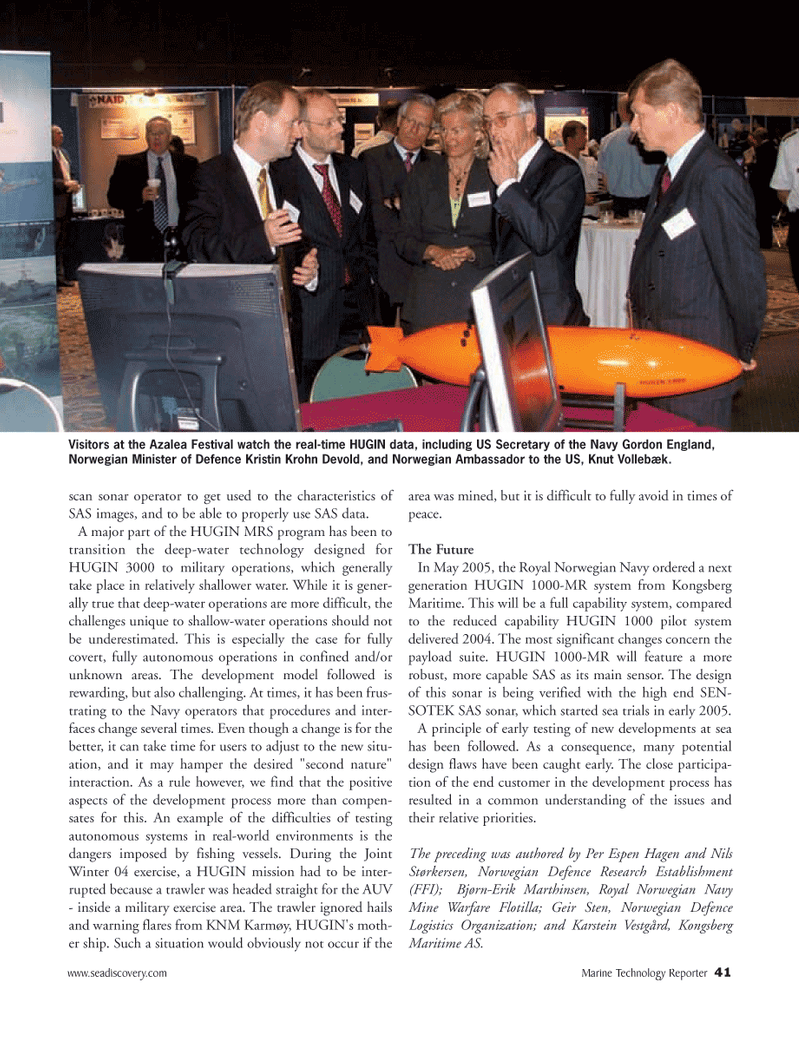
Page 41: of Marine Technology Magazine (November 2005)
Seafloor Engineering
Read this page in Pdf, Flash or Html5 edition of November 2005 Marine Technology Magazine
scan sonar operator to get used to the characteristics of
SAS images, and to be able to properly use SAS data.
A major part of the HUGIN MRS program has been to transition the deep-water technology designed for
HUGIN 3000 to military operations, which generally take place in relatively shallower water. While it is gener- ally true that deep-water operations are more difficult, the challenges unique to shallow-water operations should not be underestimated. This is especially the case for fully covert, fully autonomous operations in confined and/or unknown areas. The development model followed is rewarding, but also challenging. At times, it has been frus- trating to the Navy operators that procedures and inter- faces change several times. Even though a change is for the better, it can take time for users to adjust to the new situ- ation, and it may hamper the desired "second nature" interaction. As a rule however, we find that the positive aspects of the development process more than compen- sates for this. An example of the difficulties of testing autonomous systems in real-world environments is the dangers imposed by fishing vessels. During the Joint
Winter 04 exercise, a HUGIN mission had to be inter- rupted because a trawler was headed straight for the AUV - inside a military exercise area. The trawler ignored hails and warning flares from KNM Karmøy, HUGIN's moth- er ship. Such a situation would obviously not occur if the area was mined, but it is difficult to fully avoid in times of peace.
The Future
In May 2005, the Royal Norwegian Navy ordered a next generation HUGIN 1000-MR system from Kongsberg
Maritime. This will be a full capability system, compared to the reduced capability HUGIN 1000 pilot system delivered 2004. The most significant changes concern the payload suite. HUGIN 1000-MR will feature a more robust, more capable SAS as its main sensor. The design of this sonar is being verified with the high end SEN-
SOTEK SAS sonar, which started sea trials in early 2005.
A principle of early testing of new developments at sea has been followed. As a consequence, many potential design flaws have been caught early. The close participa- tion of the end customer in the development process has resulted in a common understanding of the issues and their relative priorities.
The preceding was authored by Per Espen Hagen and Nils
Størkersen, Norwegian Defence Research Establishment (FFI); Bjørn-Erik Marthinsen, Royal Norwegian Navy
Mine Warfare Flotilla; Geir Sten, Norwegian Defence
Logistics Organization; and Karstein Vestgård, Kongsberg
Maritime AS. www.seadiscovery.com Marine Technology Reporter 41
Visitors at the Azalea Festival watch the real-time HUGIN data, including US Secretary of the Navy Gordon England,
Norwegian Minister of Defence Kristin Krohn Devold, and Norwegian Ambassador to the US, Knut Vollebæk.
MTR#3 (33-48).qxd 11/14/2005 1:29 PM Page 41

 40
40

 42
42
